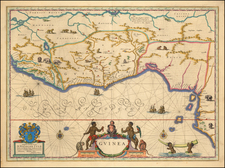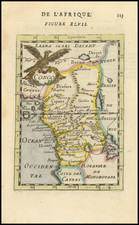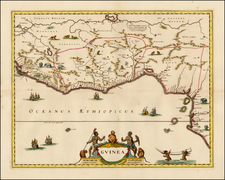Striking full-color example of Ortelius' map of the Kingdoms of Fez and Morocco, from Ortelius' Theatrum Orbis Terrarum, the first modern atlas of the world. The map shows the region from Taroudant in central Morocco through Marrakesh and into northernmost Morocco and southern Spain. The Canaries are visible in the lower left of the map.
The map includes a fabulous large cartouche, a number of sailing ships, and various sea monsters. A fabulous cartouche of West Africa appears in the upper left, entitled Congi Regni Christiani, in Africa, Nova Descriptio.
Sources
This map was compiled by Ortelius from a variety of sources, including Sanuto's 1588 Africa atlas and the 1564 Gastaldi wall map of Africa. The inset map of West Africa follows Pigafetta's map of the Congo from 1591.
The Pigafetta map of the Congo was significant for its revolutionary rejection of the Ptolemaic depiction of the interior Africa, one that was then still followed by cartographers (including Ortelius). Pigafetta disputed the traditional Ptolemaic geography of twin lakes on the same latitude near the Mountains of the Moon as the source of the Nile River. Rather, Pigafetta shows two lakes in central Africa, one above the other. The southern one feeds the Zambezi and the Limpopo. The northern lake feeds the Nile and Zaire Rivers. The northern lake is at and north of the equator, as opposed to farther south as Ptolemy placed his lakes. This map is without question the most important modern map of Africa published in the 16th century.
Sanuto's and Gastaldi's works were equally monumental in the 16th-century cartographic history of Africa. Sanuto's Africa Atlas, in reality, the only completed part of his Geografia, was one of the most referenced contemporary texts on Africa for at least one hundred years after its publication. Sanuto's maps of Africa compile from many sources and display an acute critical sense. His maps further show innovation in the reconciliation of a well-known coastline with interior topographical information that draws from several thousand years of at-times conflicting literary knowledge.
Abraham Ortelius is perhaps the best known and most frequently collected of all sixteenth-century mapmakers. Ortelius started his career as a map colorist. In 1547 he entered the Antwerp guild of St Luke as afsetter van Karten. His early career was as a business man, and most of his journeys before 1560, were for commercial purposes. In 1560, while traveling with Gerard Mercator to Trier, Lorraine, and Poitiers, he seems to have been attracted, largely by Mercator’s influence, towards a career as a scientific geographer. From that point forward, he devoted himself to the compilation of his Theatrum Orbis Terrarum (Theatre of the World), which would become the first modern atlas.
In 1564 he completed his “mappemonde", an eight-sheet map of the world. The only extant copy of this great map is in the library of the University of Basel. Ortelius also published a map of Egypt in 1565, a plan of Brittenburg Castle on the coast of the Netherlands, and a map of Asia, prior to 1570.
On May 20, 1570, Ortelius’ Theatrum Orbis Terrarum first appeared in an edition of 70 maps. By the time of his death in 1598, a total of 25 editions were published including editions in Latin, Italian, German, French, and Dutch. Later editions would also be issued in Spanish and English by Ortelius’ successors, Vrients and Plantin, the former adding a number of maps to the atlas, the final edition of which was issued in 1612. Most of the maps in Ortelius' Theatrum were drawn from the works of a number of other mapmakers from around the world; a list of 87 authors is given by Ortelius himself
In 1573, Ortelius published seventeen supplementary maps under the title of Additamentum Theatri Orbis Terrarum. In 1575 he was appointed geographer to the king of Spain, Philip II, on the recommendation of Arias Montanus, who vouched for his orthodoxy (his family, as early as 1535, had fallen under suspicion of Protestantism). In 1578 he laid the basis of a critical treatment of ancient geography with his Synonymia geographica (issued by the Plantin press at Antwerp and republished as Thesaurus geographicus in 1596). In 1584 he issued his Nomenclator Ptolemaicus, a Parergon (a series of maps illustrating ancient history, sacred and secular). Late in life, he also aided Welser in his edition of the Peutinger Table (1598).

![Fessae, et Marocchi Regna Africae Celeberr. describebat Abrah. Ortelius. 1595 [with large inset of West Africa] By Abraham Ortelius](https://storage.googleapis.com/raremaps/img/small/95634.jpg)










![(North Africa) Barbaria [Barbary]](https://storage.googleapis.com/raremaps/img/small/97498.jpg)
![[Southwestern Coast of Africa] Pas-Caart van Guinea en de Custen daer aen gelegen Van Cabo verde tot Cabo de Bona Esperanca](https://storage.googleapis.com/raremaps/img/small/46931.jpg)
![[Christian Conquest and Fortification of Djerba in 1560] Aviso Del Successo Del Arm'ata De Christiani che si truova in Barberia, & della presa del Gerbi diretta al. S. Comendator Cambiano dal S. Paulo de la gesia Comedator; et secretario del R.S. gran Mastro de la religion de Rodi, Molto Magnifico S. Miro.](https://storage.googleapis.com/raremaps/img/small/61878.jpg)
